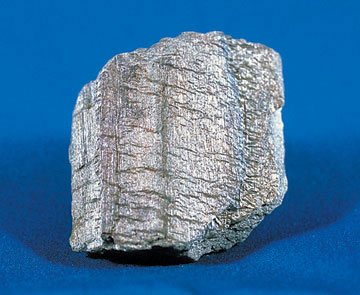Philite on:
[Wikipedia]
[Google]
[Amazon]


 Phyllite ( ) is a type of foliated metamorphic rock created from
Phyllite ( ) is a type of foliated metamorphic rock created from


 Phyllite ( ) is a type of foliated metamorphic rock created from
Phyllite ( ) is a type of foliated metamorphic rock created from slate
Slate is a fine-grained, foliated, homogeneous metamorphic rock derived from an original shale-type sedimentary rock composed of clay or volcanic ash through low-grade regional metamorphism. It is the finest grained foliated metamorphic rock. ...
that is further metamorphosed so that very fine grained white mica
Micas ( ) are a group of silicate minerals whose outstanding physical characteristic is that individual mica crystals can easily be split into extremely thin elastic plates. This characteristic is described as perfect basal cleavage. Mica is ...
achieves a preferred orientation.Stephen Marshak ''Essentials of Geology'', 3rd ed. It is primarily composed of quartz, sericite mica
Micas ( ) are a group of silicate minerals whose outstanding physical characteristic is that individual mica crystals can easily be split into extremely thin elastic plates. This characteristic is described as perfect basal cleavage. Mica is ...
, and chlorite
The chlorite ion, or chlorine dioxide anion, is the halite with the chemical formula of . A chlorite (compound) is a compound that contains this group, with chlorine in the oxidation state of +3. Chlorites are also known as salts of chlorous ac ...
.
Phyllite has fine-grained mica flakes, whereas slate
Slate is a fine-grained, foliated, homogeneous metamorphic rock derived from an original shale-type sedimentary rock composed of clay or volcanic ash through low-grade regional metamorphism. It is the finest grained foliated metamorphic rock. ...
has extremely fine mica flakes, and schist has large mica flakes, all mica flakes of which have achieved a preferred orientation. Among foliated metamorphic rocks, it represents a gradation in the degree of metamorphism between slate and schist.
The minute crystals of graphite, sericite, or chlorite, or the translucent fine-grained white mica, impart a silky, sometimes golden sheen to the surfaces of cleavage, called "phyllitic luster".
The word comes from the Greek ''phyllon'', meaning "leaf".
The protolith (or parent rock) for phyllite is shale
Shale is a fine-grained, clastic sedimentary rock formed from mud that is a mix of flakes of clay minerals (hydrous aluminium phyllosilicates, e.g. kaolin, Al2 Si2 O5( OH)4) and tiny fragments (silt-sized particles) of other minerals, especial ...
or pelite, or slate, which in turn came from a shale protolith. Its constituent platy minerals are larger than those in slate but are not visible with the naked eye. Phyllites are said to have a texture called "phyllitic sheen," and are usually classified as having formed through low-grade metamorphic conditions through regional metamorphism metamorphic facies
A metamorphic facies is a set of mineral assemblages in metamorphic rocks formed under similar pressures and temperatures.Essentials of Geology, 3rd Edition, Stephen Marshak The assemblage is typical of what is formed in conditions corresponding ...
.
Phyllite has good fissility
In nuclear engineering, fissile material is material capable of sustaining a nuclear fission Nuclear chain reaction#Fission chain reaction, chain reaction. By definition, fissile material can sustain a chain reaction with neutrons of thermal ene ...
(a tendency to split into sheets). Phyllites are usually black to gray or light greenish gray in color. The foliation is commonly crinkled or wavy in appearance. Phyllites are mostly used in decorative aggregates, interior decors, building stones, facing stones, garden decoration and curbing. Cemetry markers, commemorative tablets, creating artworks and writing slates are some of its commercial uses.
Phyllite is commonly found in the Dalradian metasediments of northwest Arran. In north Cornwall, there are Tredorn phyllites and Woolgarden phyllites.Barton, R. M. (1964) ''An Introduction to the Geology of Cornwall''. Truro: D. Bradford Barton; p. 89
References
External links
Metamorphic rocks {{Petrology-stub